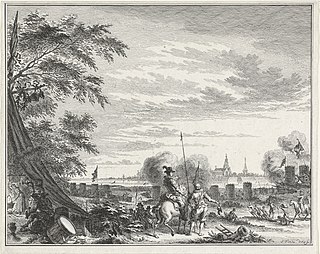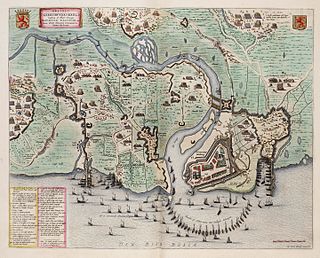
The Battle of Nieuwpoort was fought on 2 July 1600 during the Eighty Years War and the Anglo-Spanish war in the dunes near Nieuwpoort. The Anglo-Dutch companies met the Spanish veterans head-on which, although their left flank nearly broke, were able to assail them with both infantry and cavalry. The Spanish gradually scattered in all directions and left their guns on the field.

The Battle of Turnhout, also known as the Battle of Tielenheide, was fought on 24 January 1597 by allied forces of the Dutch Republic and the Kingdom of England against those of the Spanish Empire. The battle took place near Turnhout in the Southern Netherlands, and was part of the Eighty Years' War and the concurrent Anglo-Spanish War (1585–1604).

The siege of Ostend was a three-year siege of the city of Ostend during the Eighty Years' War and the Anglo–Spanish War. A Spanish force under Archduke Albrecht besieged the fortress being held initially by a Dutch force which was reinforced by English troops under Francis Vere, who became the town's governor. It was said "the Spanish assailed the unassailable; the Dutch defended the indefensible." The commitment of both sides in the dispute over the only Dutch-ruled area in the province of Flanders made the campaign continue for longer than any other during the war. This resulted in one of the longest and bloodiest sieges in world history: more than 100,000 people were killed, wounded, or succumbed to disease during the siege.

Sir Francis Vere was a prominent English soldier serving under Queen Elizabeth I fighting mainly in the Low Countries during the Anglo-Spanish War (1585–1604) and the Eighty Years' War.

The siege of Bergen op Zoom was a siege that took place between September 23 - November 13, 1588, during the Eighty Years' War and the Anglo–Spanish War. The siege took place in the aftermath of the Spanish Armada when famed commander Alexander Farnese, the Duke of Parma attempted to use his forces to besiege Bergen op Zoom, which was held by an Anglo-Dutch force under Thomas Morgan and Peregrine Bertie. An English officer named Grimstone, claiming to be a disaffected Catholic, had set up a trap during which a large Spanish assault was bloodily repulsed. An Anglo-Dutch relief column under the command Maurice of Orange arrived soon after and forced the Duke of Parma to retreat, thus ending the siege.

The siege of Rheinberg took place from the 9 to 19 August 1597 during the Eighty Years' War and the Anglo–Spanish War by a Dutch and English army led by Maurice of Orange. The siege ended with the capitulation and the withdrawal of the Spanish after much unrest in the garrison. The liberation of the city of Rheinberg was the commencement of Maurice's campaign of 1597, a successful offensive against the Spaniards during the period known as the Ten Glory Years.
The Mutiny of Hoogstraten was the longest mutiny by soldiers of the Army of Flanders during the Eighty Years' War. Frederick Van den Berg's attempt to end the mutiny by force, with a siege to recapture the town, ended in defeat at the hands of an Anglo-Dutch army under of Maurice of Nassau. After a period of nearly three years the mutineers were able either to join Maurice's army or rejoin the Spanish army after a pardon had been ratified.

The siege of Rees of 1599, also known as the relief of Rees, was an unsuccessful attempt by Protestant-German forces led by Count Simon VI of Lippe, and Anglo-Dutch forces sent by Prince Maurice of Nassau, commanded by Philip of Hohenlohe-Neuenstein and the Count Ernst of Solms, to capture the strategic stronghold of Rees, Lower Rhine, Duchy of Cleves from the Spanish forces of Don Francisco de Mendoza, Admiral of Aragon, second-in-command of the Army of Flanders, and Governor Don Ramiro de Guzmán, between 10–12 September 1599, during the Eighty Years' War and the Anglo-Spanish War (1585–1604). This Spanish victory was part of the campaign of Francisco de Mendoza and Cardinal Andrew of Austria of 1598-1599, also called the Spanish Winter of 1598-99.
The Capture of Geertruidenberg of 1589, also known as the English betrayal of Geertruidenberg, took place on April 10, 1589, at Geertruidenberg, Duchy of Brabant, Flanders, during the Eighty Years' War and the Anglo-Spanish War (1585–1604).

The siege of Sluis (1604), also known as the Sluis campaign or the Battle of the Oostburg Line, was a series of military actions that took place during the Eighty Years' War and the Anglo–Spanish War from 19 May to 19 August 1604. A States and English army under Prince Maurice of Orange and Horace Vere respectively crossed the Scheldt estuary and advanced on land taking Cadzand, Aardenburg, and IJzendijke in the Spanish Netherlands. This soon led to the culmination of the siege of the Spanish-held inland port of Sluis.

The siege of Hulst of 1596 took place between mid-July and August 18, 1596, at the city of Hulst, Province of Zeeland, Low Countries, during the Eighty Years' War, the Anglo-Spanish War (1585–1604). The siege was won by the Spanish forces of the Archduke of Austria. After a short siege, during which Maurice of Orange launched a failed attempt to relieve the city, the garrison of Dutch and English troops fell into Spanish hands on August 18, 1596.

The siege of Grave was a siege that took place between 18 July and 20 September 1602, as part of the Eighty Years' War and the Anglo–Spanish War. The Spanish-held city of Grave was besieged by a Dutch and English army led by Maurice of Orange and Francis Vere respectively. After a siege of nearly two months the city surrendered when a Spanish relief army under Francisco de Mendoza was defeated just outside the city by the besiegers. The defeat was severe enough to cause a major mutiny in the Spanish army.

The siege of Knodsenburg, Relief of Knodzenburg or also known as Battle of the Betuwe was a military action that took place during the Eighty Years' War and the Anglo–Spanish War at a sconce known as Knodsenburg in the district of Nijmegen. A siege by a Spanish army under the command of the Duke of Parma took place from 15 to 25 July 1591. The fort was defended by the Dutch Republic's commander Gerrit de Jong and his company which was then subsequently relieved through the intervention of a Dutch and English army led by Maurice of Orange and Francis Vere, respectively, on 25 July. As a result, the Spanish army was defeated and Parma managed to retreat by getting his army across the River Waal.

The siege of Coevorden was a siege that took place between 26 July and 2 September 1592 during the Eighty Years' War and the Anglo–Spanish War at the city of Coevorden by a Dutch and English force under overall command of Maurice of Nassau. The city was defended by Frederik van den Bergh who had been commissioned for the defence by King Philip II of Spain.

The siege of Geertruidenberg was a siege of the city of Geertruidenberg that took place between 27 March and 24 June 1593 during the Eighty Years' War and the Anglo–Spanish War. Anglo-Dutch troops under the commands of Maurice of Nassau and Francis Vere laid siege to the Spanish garrisoned city. The siege was unique in that the besiegers used a hundred ships, forming a semicircle in a chain on the Mass river to form a blockade. A Spanish force under the command of the Count of Mansfeld attempted to relieve the city in May, but they were defeated and later forced to withdraw. Three Governors of the city were killed – after the last fatality and as a result of the failed relief, the Spanish surrendered the city on 24 June 1593. The victory earned Maurice much fame and had thus become a steadfast strategist in the art of war.

The siege of Nijmegen was a military engagement during the Eighty Years' War and the Anglo–Spanish War which took place from 17 to 21 October 1591. The Spanish garrison in Nijmegen was besieged by a Dutch and English force under Maurice of Nassau and Francis Vere respectively and surrendered soon.

The siege of Schenkenschans was a siege that took place from 28 April to 2 May 1599 as part of the Eighty Years' War and the Anglo–Spanish War. Schenkenschans was garrisoned largely by English troops and was besieged by a Spanish force led by Francisco de Mendoza. The siege failed with losses and the Spanish were forced to retreat when a relief force arrived.

The siege of Groningen was a two-month siege which commenced on 19 May 1594, and which took place during the Eighty Years' War and the Anglo-Spanish War. The Spanish-held city of Groningen was besieged by a Dutch and English army led by Prince Maurice of Orange. The Spanish surrendered the city on 22 July, after a failed relief attempt by the Count of Fuentes.

The siege of San Andreas also known as the siege of Sint-Andries was a military event that took place during the Eighty Years' War and the Anglo–Spanish War from 28 January to 6 March 1600. The Spanish garrison of San Andreas was besieged by an Anglo-Dutch force led by Maurice of Nassau. A Spanish relief force under the command of Luis de Velasco failed to relieve the fort after having been turned back by the besiegers. The fort surrendered after the garrison mutinied and accepted payment from Maurice.

The years 1599–1609 constituted a phase of in the Eighty Years' War between the Spanish Empire and the emerging Dutch Republic. It followed the Ten Years (1588–1598) that saw significant conquests by the Dutch States Army under the leadership of stadtholders Maurice of Nassau and William Louis of Nassau-Dillenburg, and ended with the conclusion of the Twelve Years' Truce (1609–1621) on 9 April 1609. The 1599–1609 period was generally marked by a stalemate; the well-known Battle of Nieuwpoort (1600) brought the Dutch a tactical victory without long-term gain, while Spanish conquests in the Siege of Ostend (1601–1604) and Spinola's 1605–1606 campaign were effectively balanced out by the Dutch naval triumph in the Battle of Gibraltar (1607) and the Spanish state bankruptcy that same year. Financial troubles were amongst the primary motives that prompted the Dutch, and even more so the Spanish, to head to the negotiating table for a ceasefire.






















